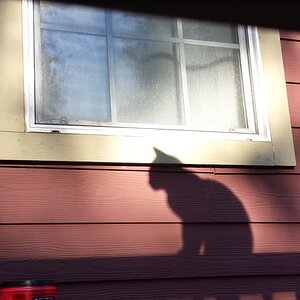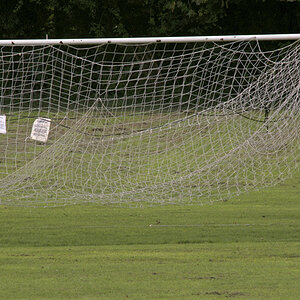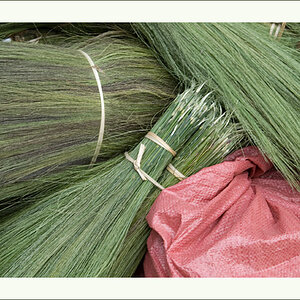Navigation
Install the app
How to install the app on iOS
Follow along with the video below to see how to install our site as a web app on your home screen.

Note: This feature currently requires accessing the site using the built-in Safari browser.
More options
You are using an out of date browser. It may not display this or other websites correctly.
You should upgrade or use an alternative browser.
You should upgrade or use an alternative browser.
wat are the benfits of telephoto
- Thread starter TTPeter
- Start date
Johnboy2978
No longer a newbie, moving up!
- Joined
- Oct 21, 2004
- Messages
- 1,797
- Reaction score
- 30
- Location
- Southwest Virginia
- Website
- www.johncountsphotography.com
- Can others edit my Photos
- Photos OK to edit
I'm not sure that I would use the term better or not necessarily. Think of lenses as tools in a tool box. Each lens has a different purpose just as a tool has a specific job. If you were doing only portraits, then a telephoto lens would not be as useful as a standard 50mm lens. The benefit of a telephoto lens is that it can cover a lot of ground. For instance, a standard telephoto lens could be considered a 70-300mm lens. It is going to be more useful for nature, wild life, sporting events, etc. You are going to use it more when you are photographing things that you might not be able to get close enough to effeciently. So if that's the kind of images you intend to shoot, then it would be much more valuable than say a 50mm fixed focal length lens. If you are going to shoot portraits, you would want a 50 or 85 or maybe 100mm fixed length lens. If you were shooting bugs for instance, you would want a macro lens. Wide angle lens would be usually like 18-55mm maybe. Does that clear it up some?
Johnboy2978
No longer a newbie, moving up!
- Joined
- Oct 21, 2004
- Messages
- 1,797
- Reaction score
- 30
- Location
- Southwest Virginia
- Website
- www.johncountsphotography.com
- Can others edit my Photos
- Photos OK to edit
It sounds like you might not be comparing apples with apples. First, a 70-300mm lens and a 100-300mm lens are basically the same lens. You get 30mm more coverage with the 70-300 of course, but all things being equal, not enough difference to pay a significant amount more. The price differential is probably due to either (1) better glass and build, (2) name brand vs. 3rd party (Canon Vs. Tamron, Sigma, etc) (3) "faster" lens that is it has a smaller aperture like f2.8 compared to the cheaper lens which maybe f3.5 or f4 or (4) combination of the above.
Post a link to both lenses so we can see what you are talking about.
Post a link to both lenses so we can see what you are talking about.
2framesbelowzero
TPF Noob!
- Joined
- Mar 24, 2006
- Messages
- 300
- Reaction score
- 1
TTPeter said:what are the benifts, and why are they so much better then normal lens
i dont know much about lenses , can some one please explain to me
Peter
In a word -Convenience.
They are comparably inferior to a dedicated (prime) lens for any given fixed focal-length but they save on bulk, weight and time - offering flexibility in a range of situations.
oh i was just at nikon's website and i was looking at the retail value of lenses,
i think it comes to convenience, like the weight and speed is a good factor,
so theres no diff in a phototele and a normal lens?, same zoom and min apature?
for example
http://www.nikon.ca/products/af-zoom-70-300ed/
vs
http://www.nikon.ca/products/afs-vr-300/
i think it comes to convenience, like the weight and speed is a good factor,
so theres no diff in a phototele and a normal lens?, same zoom and min apature?
for example
http://www.nikon.ca/products/af-zoom-70-300ed/
vs
http://www.nikon.ca/products/afs-vr-300/
Johnboy2978
No longer a newbie, moving up!
- Joined
- Oct 21, 2004
- Messages
- 1,797
- Reaction score
- 30
- Location
- Southwest Virginia
- Website
- www.johncountsphotography.com
- Can others edit my Photos
- Photos OK to edit
You really aren't comparing apples and apples with these 2 lenses. The only thing these 2 lenses have in common is the Nikon name and the maximum of 300mm. Basically, it's a combination of better glass, build, and aperture. The short answer to this is when you get to the point that you are actually shopping for a $6k, you'll know why it's better than a $500 one.
yes i know that its better glass and biuld, and the aperture, ..ahh
i just cant really put my question into words, ......
yes i know what u mean that the lenses are competely diff , i picked a bad example, hmm, how about this, what benifits do u get from better glass? better picture quality? biuld better kinda is self explanatory, but how dose glass differ?
i just cant really put my question into words, ......
yes i know what u mean that the lenses are competely diff , i picked a bad example, hmm, how about this, what benifits do u get from better glass? better picture quality? biuld better kinda is self explanatory, but how dose glass differ?
DepthAfield
TPF Noob!
From Wikipedia
Telephoto:
In photography and cinematography, a telephoto lens is a lens whose focal length is significantly longer than the focal length of a normal lens. For a 35 mm camera with a 36 mm x 24 mm format (43.3 mm diagonal), the normal lens is 50 mm and a lens of focal length 70 mm or more is considered telephoto. On the 6 cm x 6 cm format (84.9 mm diagonal) (120 film) the normal lens is 80 mm, and focal lengths above 100 mm are considered telephoto.
Telephoto lenses are best known for making distant objects appear magnified. This effect is similar to moving closer to the object, but is not the same, since perspective is a function solely of viewing distance. Two images taken from the same location, one with a wide-angle lens and the other with a telephoto lens, will show identical perspective. Telephoto lenses also have less depth of field at a given aperture than shorter lenses.
Zoom lens:
A zoom lens is a mechanical assembly of lenses whose focal length can be changed, as opposed to a prime lens, which has a fixed focal length. They are commonly used with still and video cameras, some binoculars and telescopes, and other optical instruments.
Zoom lenses are sometimes described by the ratio of their longest and shortest focal lengths. For example, a zoom lens with focal lengths ranging from 100 mm to 400 mm may be described as a "4x" zoom. The term hyperzoom is used to advertise zoom lenses with unconventionally large focal length factors, typically more than 4x and ranging up to 10x (e.g. 35 mm to 350 mm) and even 12x.
Photographic zoom lenses should not be confused with telephoto lenses, those with large focal lengths. While many zoom lenses provide telephoto capabilities, others are wide-angle zooms, that is, they have shorter than normal focal lengths, and still others are trans-standard zooms covering a range from wide-angle to telephoto.
Telephoto:
In photography and cinematography, a telephoto lens is a lens whose focal length is significantly longer than the focal length of a normal lens. For a 35 mm camera with a 36 mm x 24 mm format (43.3 mm diagonal), the normal lens is 50 mm and a lens of focal length 70 mm or more is considered telephoto. On the 6 cm x 6 cm format (84.9 mm diagonal) (120 film) the normal lens is 80 mm, and focal lengths above 100 mm are considered telephoto.
Telephoto lenses are best known for making distant objects appear magnified. This effect is similar to moving closer to the object, but is not the same, since perspective is a function solely of viewing distance. Two images taken from the same location, one with a wide-angle lens and the other with a telephoto lens, will show identical perspective. Telephoto lenses also have less depth of field at a given aperture than shorter lenses.
Zoom lens:
A zoom lens is a mechanical assembly of lenses whose focal length can be changed, as opposed to a prime lens, which has a fixed focal length. They are commonly used with still and video cameras, some binoculars and telescopes, and other optical instruments.
Zoom lenses are sometimes described by the ratio of their longest and shortest focal lengths. For example, a zoom lens with focal lengths ranging from 100 mm to 400 mm may be described as a "4x" zoom. The term hyperzoom is used to advertise zoom lenses with unconventionally large focal length factors, typically more than 4x and ranging up to 10x (e.g. 35 mm to 350 mm) and even 12x.
Photographic zoom lenses should not be confused with telephoto lenses, those with large focal lengths. While many zoom lenses provide telephoto capabilities, others are wide-angle zooms, that is, they have shorter than normal focal lengths, and still others are trans-standard zooms covering a range from wide-angle to telephoto.
Torus34
No longer a newbie, moving up!
- Joined
- Jan 26, 2006
- Messages
- 2,117
- Reaction score
- 37
- Location
- Tottenville, Staten Island, NYC USA
- Can others edit my Photos
- Photos OK to edit
The main advantages of a telephoto lens are:
1. Allows you to fill the frame with a subject from a grerater distance than a 'normal' lens. [A normal lens is one with a focal length approximately equal to the diagonal measurement of the film frame.]
2. Allows you to make a distant object appear larger in relationship to a foreground object. This can become quite important when you begin to concentrate on composition.
3. All things being equal [which they rarely are . . .], the more expensive telephoto will have a greater maximum aperture. This is of minimal consequence if you are working from a tripod.
4. On resolution [sharpness]: This is nice to have, of course, but the cost of an almost insignificant improvement can be quite high. If your picture has great lighting and composition, no one other than a photo wonk will notice a slight decrease or increase in resolution.
5. In some special situations where you cannot get closer to a subject, a telephoto may make the difference between making a picture and walking sadly away.
1. Allows you to fill the frame with a subject from a grerater distance than a 'normal' lens. [A normal lens is one with a focal length approximately equal to the diagonal measurement of the film frame.]
2. Allows you to make a distant object appear larger in relationship to a foreground object. This can become quite important when you begin to concentrate on composition.
3. All things being equal [which they rarely are . . .], the more expensive telephoto will have a greater maximum aperture. This is of minimal consequence if you are working from a tripod.
4. On resolution [sharpness]: This is nice to have, of course, but the cost of an almost insignificant improvement can be quite high. If your picture has great lighting and composition, no one other than a photo wonk will notice a slight decrease or increase in resolution.
5. In some special situations where you cannot get closer to a subject, a telephoto may make the difference between making a picture and walking sadly away.
Dave_D
TPF Noob!
TTPeter. You should probably surf around the Nikon site or google even and educate yourself about what all of the abbreviations in a lens description mean( AFS/VR/IF/etc.). A little time gaining this knowledge will take you a long way in understanding what you are looking at and the correlation of the price.
Similar threads
- Replies
- 0
- Views
- 329
- Replies
- 0
- Views
- 183





![[No title]](/data/xfmg/thumbnail/32/32930-09414fc020c2a60a456ff59a05c5ef8f.jpg?1619735759)
![[No title]](/data/xfmg/thumbnail/42/42054-e8278f89f6a543cad8fd644e37b064f3.jpg?1619739992)
![[No title]](/data/xfmg/thumbnail/32/32933-a3726bc86a7c36fb222612f8aeab6b84.jpg?1619735763)




![[No title]](/data/xfmg/thumbnail/42/42055-105f2ee23a1fd79c786de42c5578274b.jpg?1619739992)